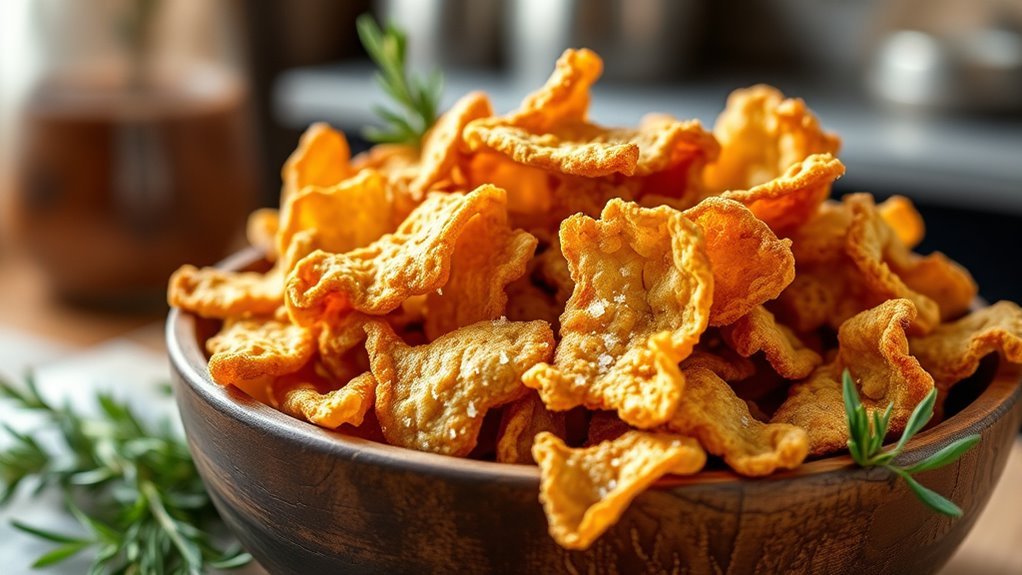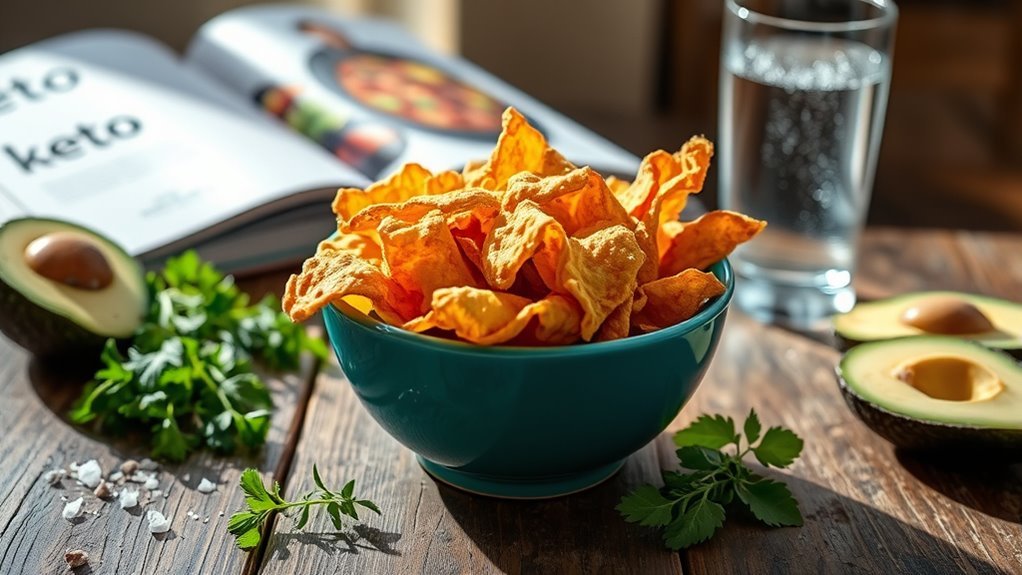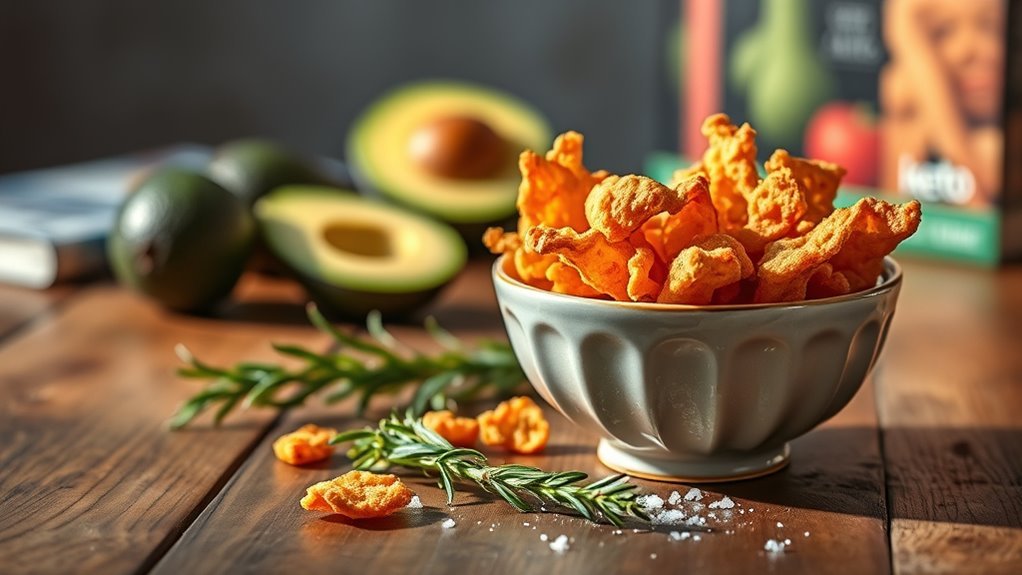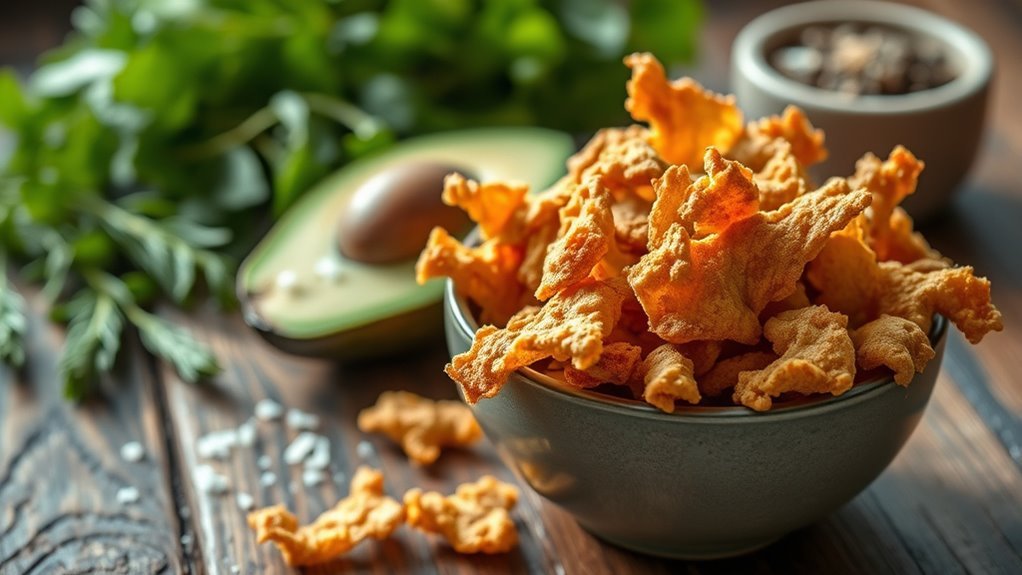Yes, pork rinds are keto-friendly! They contain about 9 grams of protein per ounce and have zero carbohydrates, making them an excellent snack for maintaining ketosis. However, keep in mind that they are high in saturated fats and sodium, so moderation is key. You can use them creatively in various dishes or enjoy them as a crunchy snack. If you want to learn about the best ways to incorporate pork rinds into your meals, there’s more to discover!
Understanding the Nutritional Profile of Pork Rinds

When diving into the world of pork rinds, it’s essential to grasp their nutritional profile. These crispy snacks come in various pork rind types, including traditional, spicy, and flavored options. Generally, pork rinds are high in protein and low in carbohydrates, making them appealing for those seeking low-carb snacks. A nutritional comparison reveals that one ounce contains around 9 grams of protein and zero carbs, but also note the significant fat content, primarily saturated fats. While they can fit into certain dietary plans, moderation is key. Understanding their nutritional value can empower you to make informed choices about incorporating pork rinds into your diet while enjoying the freedom to indulge responsibly. Additionally, their low-carb nature aligns well with the ketogenic diet principles, allowing for a satisfying snack without compromising your carb intake.
The Benefits of Adding Pork Rinds to a Keto Diet

Adding pork rinds to your keto diet can offer several advantages. They’re a low-carb snack option, making it easy to satisfy cravings without disrupting your carb intake. Plus, their high protein content and versatility in recipes can enhance your meals while keeping you on track with your dietary goals. Additionally, pork rinds are a great source of healthy fats, which can help support your overall energy levels on a keto diet.
Low-Carb Snack Option
While many snack options can derail a ketogenic diet, pork rinds emerge as a standout choice due to their low-carb content and high protein levels. They’re a versatile snack that can easily fit into your meal plan, allowing you to indulge without guilt. With a variety of pork rinds recipes available, you can get creative in the kitchen, using them as crunchy toppings or in keto-friendly casseroles. As you explore snacking alternatives, consider that these crispy treats not only curb your hunger but also provide satisfying texture without the carbs found in traditional snacks. By incorporating pork rinds into your diet, you maintain your keto goals while enjoying the freedom to snack deliciously. Additionally, their composition of high protein and minimal carbohydrates makes them an excellent fit for maintaining ketosis.
High Protein Content
Pork rinds are an excellent source of protein, making them a valuable addition to a ketogenic diet. With about 8 grams of protein per ounce, they provide a substantial boost compared to many typical snack options. When you look at snack comparisons, pork rinds stand out for their high protein content, especially when compared to chips or crackers that are often carb-heavy and low in protein. Incorporating pork rinds into your diet not only satisfies your hunger but also aids in muscle repair and growth, essential for those on a low-carb plan. They can help you meet your protein needs while keeping you in ketosis. Additionally, pork rinds are suitable for high-fat, low-carbohydrate diets, making them an ideal snack for keto enthusiasts. So, if you’re looking for protein sources that fit your lifestyle, pork rinds are a great choice.
Versatile Culinary Ingredient
When you’re on a ketogenic diet, finding versatile ingredients that can enhance your meals is key, and pork rinds fit the bill perfectly. These crunchy snacks aren’t just for munching; they’re a fantastic addition to various pork rind recipes. You can use them as a breading for meats, a topping for casseroles, or even as a base for keto-friendly nachos. Additionally, pork rinds are a great source of high-fat content, making them an ideal choice for maintaining ketosis.
| Culinary Uses | Benefits | Recipe Ideas |
|---|---|---|
| Breading for meats | Low-carb alternative | Fried chicken with pork rinds |
| Topping for salads | Adds crunch and flavor | Caesar salad with pork rinds |
| Base for nachos | Satisfies snack cravings | Pork rind nachos |
| Ingredient in dips | Enhances texture | Pork rind dip |
| Crust for quiches | Gluten-free option | Pork rind quiche |
Incorporating pork rinds into your diet opens up endless culinary possibilities!
Potential Drawbacks of Eating Pork Rinds

While pork rinds can be a tasty addition to your keto diet, there are some potential drawbacks to contemplate. They often contain high levels of sodium, which can impact your blood pressure, and they lack essential nutrients that your body needs. Additionally, if you have a sensitivity to pork or related allergens, it’s important to be cautious when including them in your meals.
High Sodium Content
Although pork rinds can be a tasty, low-carb snack option for those following a keto diet, their high sodium content is a significant drawback. Consuming too much sodium can lead to potential health issues, including high blood pressure and increased risk of heart disease. If you’re mindful of sodium health, consider these tips:
- Limit portion sizes of pork rinds to manage sodium intake.
- Pair them with low-sodium dips or toppings.
- Explore sodium alternatives, like homemade seasoning blends.
- Stay hydrated to help balance sodium levels in your body.
- Opt for brands that offer lower-sodium options.
Lack of Nutrients
Despite their appeal as a crunchy, low-carb snack, pork rinds lack essential nutrients that are important for a balanced diet. While they provide protein and fat, their overall nutrient density is low. You might find yourself craving vitamins and minerals that pork rinds simply don’t deliver. For instance, they’re generally deficient in vitamin content, which can lead to deficiencies if consumed as a primary snack choice. Relying too heavily on pork rinds may prevent you from getting the nutrients needed for peak health. If you’re seeking freedom in your diet, it’s essential to include a variety of nutrient-dense foods, ensuring you meet your vitamin and mineral needs while enjoying your snacks. Balance is key!
Potential Allergic Reactions
If you’re pondering adding pork rinds to your diet, it’s important to be aware of potential allergic reactions that some individuals may experience. While pork rinds can be a tasty snack for many, they can trigger pork rinds allergies or ingredient sensitivities in others. Here are some key points to contemplate:
- Common allergens: Pork, seasonings, or preservatives might cause reactions.
- Symptoms: Hives, swelling, or gastrointestinal issues can occur.
- Cross-contamination: Always check if they’re processed in facilities handling allergens.
- Personal history: If you’ve had food allergies before, proceed with caution.
- Consult a doctor: If you’re unsure, discussing with a healthcare professional is wise.
Being informed can help you enjoy pork rinds while staying mindful of your health.
How to Choose the Best Pork Rinds
When you’re on the hunt for the best pork rinds, it’s essential to take into account a few key factors to guarantee you’re making a healthy choice. First, check the ingredient list—opt for options without artificial flavors or preservatives. Look for brands that highlight their cooking methods; traditionally fried rinds tend to have richer flavor profiles compared to baked varieties. Pay attention to the fat content as well; some brands offer rinds with less fat, which can suit your dietary needs better. Finally, consider the seasoning—choose flavors that appeal to your palate but don’t compromise your health. By keeping these factors in mind, you can enjoy a delicious, guilt-free snack that aligns with your keto lifestyle. Additionally, monitoring carbohydrate intake is crucial to ensure that your snack choices support your keto goals.
Creative Ways to Incorporate Pork Rinds Into Meals
While many think of pork rinds as a standalone snack, they can be creatively integrated into various meals to enhance flavor and texture. You can enjoy these crunchy delights in numerous ways, not just as a quick bite. Consider trying:
- Pork rind nachos: Replace traditional chips with crushed pork rinds for a low-carb twist.
- Crispy topping: Sprinkle crushed rinds on casseroles or baked dishes for added crunch.
- Salad croutons: Use pork rinds as a flavorful alternative to croutons in salads.
- Meat coatings: Crush rinds and use them to coat chicken or fish before frying or baking.
- Soups: Add whole or crushed rinds to soups for an unexpected texture and flavor boost.
Additionally, pork rinds are a great source of high protein content, which aligns well with keto diet principles. With these ideas, you can elevate your meals while enjoying a keto-friendly option!
Alternatives to Pork Rinds for Low-Carb Snacking
Although pork rinds are a popular choice for low-carb snacking, there are plenty of other options that can satisfy your cravings without compromising your ketogenic diet. Consider healthy alternatives like cheese crisps or kale chips, which offer a satisfying crunch with minimal carbs. Nut-based snacks, such as almonds or macadamia nuts, provide healthy fats and protein, making them great for keeping you full. You could also try beef or turkey jerky, ensuring they’re sugar-free for a low-carb option. If you’re in the mood for something sweet, dark chocolate with a high cocoa content can be a delightful treat. Incorporating low-carb vegetables into your snacks can further enhance your nutritional intake while staying true to your keto lifestyle. With these alternatives, you can enjoy snacking while staying true to your keto lifestyle.
Summary of Pork Rinds in a Keto Lifestyle
Pork rinds can be an excellent addition to a keto lifestyle, primarily due to their high protein content and zero carbohydrates. They’re a versatile snack that offers both crunch and flavor, making them a great alternative to traditional snacks. If you’re looking for ways to incorporate pork rinds into your diet, consider these options:
- Create delicious pork rind nachos with cheese and toppings.
- Use crushed pork rinds as a low-carb breading for chicken or fish.
- Mix them into your favorite dip for added texture.
- Try pork rind recipes in casseroles for a unique twist.
- Enjoy them plain as a satisfying keto snack alternative.
Incorporating pork rinds can also help maintain low-carb alternatives to traditional high-carb snacks, enhancing your keto journey while keeping your taste buds happy!
Frequently Asked Questions
Do Pork Rinds Contain Any Carbohydrates?
Yes, pork rinds contain minimal carbohydrates. In fact, their carb content is often negligible, making them a popular choice for low-carb diets. When you look at pork rind nutrition, you’ll see they primarily consist of protein and fat, with less than one gram of carbs per serving. This makes them an excellent snack option if you’re aiming to reduce your carb intake while enjoying a crunchy treat. Enjoy them guilt-free!
Can Pork Rinds Be Part of a Vegan Diet?
Pork rinds can’t be part of a vegan diet, as they’re made from pig skin. If you think of a lush garden, filled with vibrant plants, that’s where you’ll find vegan alternatives. Foods like chickpea puffs or kale chips can satisfy crunchy cravings without compromising dietary restrictions. Embracing a vegan lifestyle offers you the freedom to explore diverse flavors while nurturing your body, making it easier to find satisfying options that align with your values.
Are There Any Allergens in Pork Rinds?
Yes, pork rinds can contain allergens, primarily due to cross-contamination during production. While the main ingredient, pork skin, isn’t a common allergen, the sourcing of ingredients can introduce risks, especially if other additives or seasonings are involved. Always check labels for potential allergens like gluten or spices. If you have specific sensitivities, it’s best to research the brand and their ingredient sourcing practices before indulging in pork rinds.
How Should Pork Rinds Be Stored?
To store pork rinds properly, keep ’em in an airtight container at room temperature. This helps maintain their crunch and flavor. If you want to extend their shelf life, consider refrigerating them, but be mindful they might lose some crispness. Always check for any signs of moisture or spoilage before eating. Following these storage tips guarantees you enjoy your pork rinds at their best, maximizing both taste and freshness!
What Are the Best Brands of Pork Rinds?
When it comes to the best brands of pork rinds, you’ll find that about 25% of consumers prefer spicy flavors! Popular brands like Epic, Chicharrones, and Utz offer a variety of pork rind flavors, from classic to barbecue, ensuring you’ve got plenty of options to satisfy your cravings. Look for brands that prioritize quality ingredients and minimal processing, so you can enjoy your snacks while embracing a healthier lifestyle.


